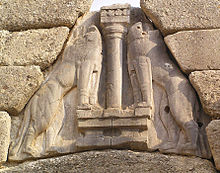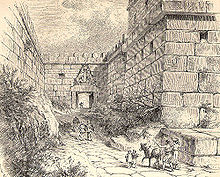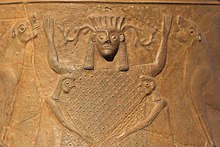Lion Gate
| Lion Gate | |
|---|---|
| Native name Greek: Πύλη των Λεόντων | |
 | |
| Location | Mycenae |
| Area | Argolis, Greece |
| Built | 1250 BC |
| Built for | Main entrance of the Mycenae citadel |
| Architectural style(s) | Conglomerate Ashlar |
Lion Gate (Greek: Πύλη των Λεόντων) is the popular modern name for the main entrance of the Bronze Age citadel of Mycenae in Southern Greece. It was erected during the thirteenth century BC, around 1250 BC, in the northwestern side of the acropolis. In modern times, it was named after the relief sculpture of two lions or lionesses in a heraldic pose that stands above the entrance.[1]
The gate is the sole surviving monumental piece of Mycenaean sculpture,[2] as well as the largest surviving sculpture in the prehistoric Aegean.[3] It is the only monument of Bronze Age Greece to bear an iconographic motif that survived without being buried underground. It is the only relief image that was described in the literature of classical antiquity, such that it was well known prior to modern archaeology.[4]
Entrance
[edit]
The greater part of the cyclopean wall in Mycenae, including the gate, was built during the second extension of the citadel that occurred in the Late Helladic period IIIB (thirteenth century BC).[5] At that time, the extended fortifications also enclosed inside the city wall Grave Circle A, a burial place for royal families during the sixteenth century BC. This grave circle was found east of this gate, where a peribolos wall also was built.[6] After the expansion, Mycenae could be entered by two gates, a main entrance and a postern,[7][8] while undoubtedly, the most extensive feature was the remodeling of the main entrance to the citadel, now known as the Lion Gate, in the northwestern side built circa 1250 BC.[9]
The gate was approached by a partly natural, partly engineered ramp on a northwest-southeast axis. The eastern side of the approach is flanked by the steep smooth slope of the earlier enceinte. This was embellished with a new facade of conglomerate. On the western side a rectangular bastion was erected, 14.80 m (49 ft) long and 7.23 m (24 ft) wide, built in pseudo-ashlar style of enormous blocks of conglomerate. The term "Cyclopean" has been applied to the style to imply that the ancient structures had been built by the legendary race of giants whose culture was presumed to have preceded that of the Classical Greeks, as described in their myths. Between the wall and the bastion, the approach narrows to a small open courtyard measuring 15 m × 7.23 m (49 ft × 24 ft), possibly serving to limit the numbers of potential attackers on the gate. The bastion on the right side of the gate facilitated defensive actions against the right hand side of attackers, which would be vulnerable, as normally the attackers would carry their shields on their left arms. At the end of the approach stands the gate.[8]
Construction
[edit]
The gate is a massive and imposing construction, standing 3.10 m (10 ft) wide and 2.95 m (10 ft) high at the threshold. It narrows as it rises, measuring 2.78 m (9 ft) below the lintel. The opening was closed by a double door mortised to a vertical beam that acted as a pivot around which the door revolved.[7]
The gate consists of two great monoliths capped with a huge lintel that measures 4.5×2.0×0.8 m (15×7×3 ft). Above the lintel, the masonry courses form a corbelled arch, leaving an opening that lightens the weight carried by the lintel. This relieving triangle is a great limestone slab on which two confronted lionesses, carved in high relief, stand on either sides of a central pillar. The heads of the animals were fashioned separately and are missing, but their necks are present.[3] The pillar, specifically, is a Minoan-type column that is located on top of an altar-like platform upon which the lionesses rest their front feet.[9]

Early imagery of a deity that was found at Knossos presents a goddess flanked clearly by two lions or lionesses, establishing a continuity in religious imagery when later, the deity is represented abstractly by a column. It clearly identifies the species of feline, because of the characteristic tuft at the end of the tail, not present in any other feline species.

The imposing gate of the citadel with the representation of the lionesses was an emblem of the Mycenaean kings and a symbol of their power to both subjects and foreigners.[9] It also has been argued that the lions are a symbol of the goddess Hera.[10]
This gate may be compared to the gates of the Hittite Bronze Age citadel of Hattusa, in Asia Minor.[9][11] Since the heads of the animals were of a different material from their bodies and originally were fashioned to look toward those approaching below,[12] a number of scholars have speculated that these might have been composite beasts, probably sphinxes, in the typical Middle Eastern tradition.[3]
On the top of the pillar is a row of four discs, apparently representing rafters supporting a further piece of sculpture that has since been lost.[13] Another view proposes: above the head of the column and what is probably a slab supporting an architrave is a row of discs (ends of transverse beams) and another slab the same size as the slab on top of the column. The beams and the block above them represent a more extended superstructure shortened here because of the diminishing space in the triangle.[14] Thus, this author proposes that no further piece of sculpture has been lost.

The design of the gate had precedents in other surviving artworks of the time; a similar design was depicted on fifteenth-century BC Minoan seals and a gem found at Mycenae. On a pithos from Knossos, the same imagery exists depicting a goddess flanked by two lionesses. Many other pieces of Mycenaean artwork share the same basic motif of two opposed animals separated by a vertical divider, such as two lambs facing a column and two sphinxes facing a sacred tree representing a deity.[13] The architectural design in the gate relief may reflect an entrance of a type characterized by a central support, commonly a single column. More specifically, the gate relief may allude to the propylon (structure forming the entrance) that provides the main direct access to the palace. The lions acted as guardians to the entrance of the palace. If so, the symbol of a sanctified palace entrance would have appeared above the gate of the fortifications: a double blessing.[14]
Beyond the gate and inside the citadel was a covered court with a small chamber, which probably functioned as a guard post. On the right, adjacent to the wall, was a building that has been identified as a granary because of the pithoi found there containing carbonized wheat.[9]
Excavations
[edit]| External videos | |
|---|---|
 | |
The gate stood in full view of visitors to Mycenae for centuries. It was mentioned by the ancient geographer Pausanias in the second century AD.[15] The first correct identification of the gate in modern literature was during a survey conducted by Francesco Grimani, commissioned by the Provveditore Generale of the Kingdom of the Morea in 1700,[16] who used Pausanias's description of the gate to identify the ruins of Mycenae.[17][18][19]
In 1840, the Greek Archaeological Society undertook the initial clearing of the site from debris and soil that had accumulated to bury it, and in 1876 Heinrich Schliemann, guided by Pausanias's accounts, excavated the area south of the gate.[15]
See also
[edit]- Cyclopean masonry
- Grave Circle A, Mycenae
- History of lions in Europe
- Mycenaean civilization
- Royal Institute of British Architects, whose emblem is a modified representation of the gate sculpture
References
[edit]Notes
- ^ Gates 2003, pp. 136–137.
- ^ Hampe & Simon 1981, p. 49: "The lions, who looked out over the land, served to protect the gate and the city. They also show that the city, and the king who ruled it, stood under the protection of the goddess Hera. The Lion relief is the sole monumental piece of Mycenaean sculpture which has come down to us."
- ^ Jump up to: a b c Kleiner 2009, pp. 91–92.
- ^ Blakolmer 2010, p. 49: "The Lion Gate and its relief block are particularly prominent and stand out amongst all other well-known monuments of Bronze Age Greece for several reasons. It is the only monument of this period bearing an iconographic motif which, since its construction in the 13th century b.C. was never buried underground, but stood continuously in the open and could be seen by visitors. Therefore, it neither had to be discovered nor unearthed and thus cannot be connected to any famous discoverer's name such as Heinrich Schliemann, Christos Tsountas, Alan Wace or other excavators at Mycenae. Furthermore, the triangular stone block above the door lintel represents the most monumental sculpture known to date from the Aegean Bronze Age, with a base line of 3.60 m and a height of more than 3 m. There probably never existed any larger sculpture in prehistoric Greece. Moreover, this monument presents the only relief image of Bronze Age Greece which is described in the literature of classical antiquity. It is a reasonable assumption that Homer had this image in mind when he described the entrance to the Phaeacian palace of Alkinoos as flanked by golden and silver guardian dogs, a work created by the god Hephaistos. More accurate are the references to this gate and its relief decoration made by Pausanias and others ascribing to them a workmanship by the Cyclopes. On the contrary, Strabo erroneously stated that no traces of the capital of the Mycenaeans survived."
- ^ Mylonas 1957, pp. 33–34.
- ^ Mylonas 1957, p. 114.
- ^ Jump up to: a b Mylonas 1957, p. 24.
- ^ Jump up to: a b Iakovidis 1983, p. 30.
- ^ Jump up to: a b c d e "The Bronze Age on the Greek Mainland: Mycenaean Greece – Mycenae". Foundation of the Hellenic World. 1999–2000. Retrieved 5 June 2014.
- ^ O'Brien 1993, p. 125: "Finally, there is Mycenae where the famous Lion Gate may have been inspired by a Heraian symbol and where the iconography provides evidence consistent with the view that "Hera" had cultic hegemony there."
- ^ Neer 2012, pp. 57–58.
- ^ Younger 1978, p. 15.
- ^ Jump up to: a b Castleden 2005, pp. 126–127.
- ^ Jump up to: a b Shaw, Maria C. (1986). "The Lion Gate Relief at Mycenae Reconsidered" (PDF). TSpace (University of Toronto). Archaeological Society of Athens, Greece. Retrieved 16 February 2016.
- ^ Jump up to: a b Mylonas 1957, p. 8.
- ^ Beaudouin 1880, pp. 206–210.
- ^ Pausanias. Description of Greece, 2.16.5.
- ^ Blakolmer 2010, p. 50: "Thus it is no wonder that the Lion Gate attracted the attention of European scholars who visited this prominent city-gate in the Argolid - a region constituting not only a focal point of antiquity but also the heart-land of early modern Greece and thus presenting good preconditions for foreign travellers and scholars in the 19th century. Mycenae's first identification by a European traveller was by M. de Monceaux in 1669, while the first mention of the Lion Gate is due to the Venetian engineer Francesco Vandeyk in 1700." [Note: The interpretation of the 1669 visit is contradicted by Moore, Rowlands & Karadimas 2014 where de Monceaux had not visited Mycenae, having mistakenly identified an acropolis as Mycenae on his travels to Tiryns.]
- ^ Moore, Rowlands & Karadimas 2014, p. 4: "The first modern, correct, identification of Mycenae seems to have been made in 1700, when the government of Venice ordered Francesco Grimani, Proveditor General of the Armies in Morea, to register all their properties in the Peloponnese. The record was completed under the direction of the engineer, Francesco Vandeyk, who not only made detailed plans for each village, but also studied and described ancient monuments. Among them was the ancient site of Mycenae which he was able to identify on the basis of Pausanias' description. Vandeyk reported a monumental entrance where a triangular relief was sculpted with two lions disposed heraldically against a column. He noted that these lions stepped their forepaws on two altars and, as a result, the entrance is known today as the Lion Gate. Indeed, Pausanias' own description of the Lion Gate was so accurate that it did not leave any doubt that the monumental acropolis, close to the moderm village of Charvati, was the site identified by the ancient author as Agamemnon's citadel."
Sources
[edit]- Beaudouin, Mondry (1880). "Fragments d'une description de l'Argolide faite en 1700 par un ingénieur italien". Bulletin de correspondance hellénique. 4: 206–210. doi:10.3406/bch.1880.4318.
- Blakolmer, Fritz (2010). "Images and Perceptions of the Lion Gate Relief at Mycenae during the 19th Century". In F. Buscemi (ed.). The Representation of Ancient Architecture in the XIXth Century. Cogitata. pp. 49–66.
- Castleden, Rodney (2005). Mycenaeans. London, United Kingdom: Routledge. ISBN 978-0-415-24923-2.
- Gates, Charles (2003). Ancient Cities: The Archaeology of Urban Life in the Ancient Near East and Egypt, Greece, and Rome. New York, New York: Routledge. ISBN 0-415-12182-5.
- Hampe, Roland; Simon, Erika (1981). The Birth of Greek Art: From the Mycenaean to the Archaic Period. New York: Oxford University Press. ISBN 978-0-19-520226-7.
- Iakovidis, Spyros E. (1983). Late Helladic Citadels on Mainland Greece. Leiden, The Netherlands: E. J. Brill. ISBN 90-04-06571-7.
- Kleiner, Fred S. (2009). Gardner's Art Through the Ages: A Global History. Cengage Learning Incorporated. ISBN 978-0-495-11549-6.
- Moore, Dudley; Rowlands, Edward; Karadimas, Nektarios (2014). In Search of Agamemnon: Early Travellers to Mycenae. Newcastle upon Tyne: Cambridge Scholars Publishing. ISBN 978-1-4438-5776-5.
- Mylonas, George Emmanuel (1957). Ancient Mycenae: The Capital City of Agamemnon. Princeton, NJ: Princeton University Press.
- Mylonas, George Emmanuel (1966). Mycenae and the Mycenaean Age. Princeton, NJ: Princeton University Press. ISBN 9780691035239.
- Neer, Richard T. (2012). Greek Art and Archaeology: A New History, c. 2500–c. 150 BCE. New York, NY: Thames & Hudson. ISBN 9780500288771. OCLC 745332893.
- O'Brien, Joan V. (1993). The Transformation of Hera: A Study of Ritual, Hero, and the Goddess in the Iliad. Lanham, Maryland: Rowman & Littlefield Publishers, Incorporated. ISBN 978-0-8476-7808-2.
- Younger, John G. (1978). "The Mycenae-Vapheio Lion Group". American Journal of Archaeology. 82 (3). Archaeological Institute of America: 285–299. doi:10.2307/504459. hdl:1808/5292. JSTOR 504459. S2CID 192635999.
Further reading
[edit]- Aström, P.; Blomé, B. (1964). "A Reconstruction of the Lion Gate Relief at Mycenae". Opuscula Atheniensia (OpAth). 5: 159–191.
- Blackwell, Nicholas G. (July 2014). "Making the Lion Gate Relief at Mycenae: Tool Marks and Foreign Influence". American Journal of Archaeology. 118 (3). Archaeological Institute of America: 451–488. doi:10.3764/aja.118.3.0451. JSTOR 10.3764/aja.118.3.0451. S2CID 193336855.





